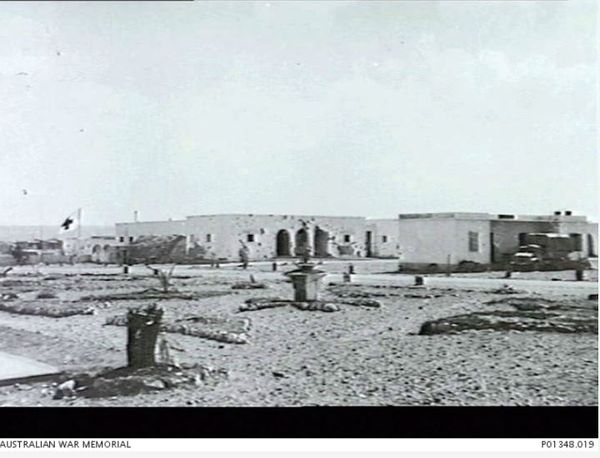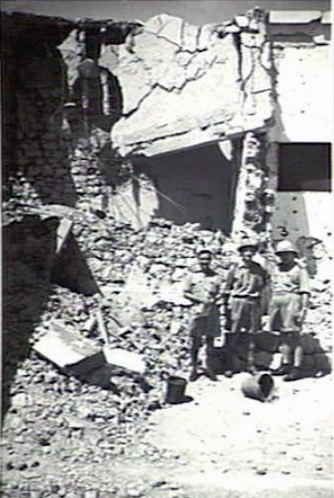Difference between revisions of "2/4th Australian General Hospital"
From Our Contribution
(→Patients) |
|||
| Line 76: | Line 76: | ||
* [[Douglas Edward Cleave Steer]] 30 Aug - 6 Sep 1941 | * [[Douglas Edward Cleave Steer]] 30 Aug - 6 Sep 1941 | ||
| − | ''1943 Redbank, Brisbane'' | + | ''1943 - 1944 Redbank, Brisbane'' |
* [[Agnostino Ugo Tognolini]] 30 Nov - 1 Dec 1943 | * [[Agnostino Ugo Tognolini]] 30 Nov - 1 Dec 1943 | ||
* [[Robert Henry Fletcher]] 15 - 18 Nov 1943 | * [[Robert Henry Fletcher]] 15 - 18 Nov 1943 | ||
| + | * [[Clarence Malarkey]] 20 - 28 Feb 1944 | ||
''1945 Labuan'' | ''1945 Labuan'' | ||
Revision as of 17:43, 30 October 2020
General Information
Staffing increased as men were called up, and then on 11 Jun 1940 the first nursing staff arrived. Initial staff were primarily Victorians, although some were from both South and Western Australia. Intensive training followed along with looking after patients for the Puckapunyal training camp before in November when pre-embarkation leave was granted. On 29 Dec 1940 the unit embarked on SS Mauretania as part of convoy US 8. Other ships were the Queen Mary, the Aquitania, Dominion Monarch', and the Awatea
After a short stay in Fremantle (2 - 4 January) the convoy sailed to Ceylon, arriving there on 11 Jan 1941. On 15 Jan they were transferred to the HMT Y3 Nevasa, one of 15 smaller ships that transported the troops to Egypt. On arrival in Egypt the nurses were detached to assist the 2/2 AGH which was busy treating patients from the Western Desert campaign against the Italians. The male members of the unit disembarked at Port Tewfik on 2 Feb 1941 and travelled by train to Abd El Kadr in the Amiriya district west of Alexandria.
The hospital then under construction had only one water point and in most other respects was totally unsuitable as a hospital site. However, before the hospital was able to accept patients, it was moved further west, beginning on 28 Feb 1941 when they travelled to Alexandria to board the Kight of Malta a ship described as a miserable, little evil smelling tub. Destined for Tobruk, she ran aground in very heavy seas somewhere between Bardia and Tobruk on 4 Mar 1941. All survived and were rescued and sent to Bardia. The recovery of over 100 tons of medical supplies requiring the construction of a road to the wreck site took some time and delayed the unit from its objective of setting up a hospital in Barce, in western Libya. Eventually some began to arrive in Barce between 11 and 14 March. After operating for 10 days they were advised to pack up and return to Tobruk as the Germans were massing for a major attack. On 26 Mar 1941 the 2/4th AGH began a withdrawal to Tobruk where it was to remain until 21 Oct 1941. The female staff arrived on 28 Mar 1941, but due to the uncertain military position, they were withdrawn on 7 Apr 1941 aboard the British Hospital Ship Vita. This loss of trained staff had a major effect on the operations of the hospital. From 9 Apr 1941 Tobruk was under siege. On 10 Apr 1941 both the beach section of the hospital, and the main part were bombed and strafed by German aircraft. Several key staff were killed along with 32 patients. While in Tobruk the hospital treated more than 14,000 soldiers, having seen more than 34,000.
Replacedin Trobuk by a British unit, they returned to Alexandria by destroyer, and then by truck to Amiriya before boarding a train for an army cam[ at Beit Jirja in Palestine. Following leave they were tasked with opening a hospital in Jerusalem, and began to do so from 13 Nov 1941. All female staff were for the first time included within the hospital. While based in Jerusalem, staff also escorted patients by Ambulance Train to El Kantara, across the canal and on to Cairo. On 15 Jan 1942 the 2/4th AGH were told to transfer all patients to the 2/6th AGH and to pack for service in a tropical area. However, given the rapid Japanese advances, the 2/4th AGH was held up at Kilo 89 in Palestine during the rest of January and February until on 12 Mar 1942 its main body embarked on SS Westernland in Port Tewfik for an unknown destination.
Arriving in Colombo on 25 Mar 1942 it was too late for them to join the troops for Java (lucky). Disembarked they were asked to open a hospital at St Peter's College, and this was done by 30 Apr 1942. However, after manning outposts all around the island as precautions against an invasion, on 20 Jun 1942 they were told to close the hospital by 27 Jun 1942. On 13 Jul 1942, split between six transports, the unit sailed for Port Melbourne where they were feted and granted leave.
Once the troops had returned to Seymour from their leave they underwent a re-equipment and retraining regime, with some of their new staff loaned out to other hospitals for training and experience. However, they were soon to move north, to Redbank in Queensland, arriving there on 14 Oct 1942 to find the hospital still under construction. Intended to be a 600 bed hospital it grew quickly to 750 as it became part of the long chain of hospitals treating patients from New Guinea. (From 56,855 casualties treated by the system, only 6,154 or 10.8% were battle casualties. The remainder either from tropical diseases or malaria.) Small groups of staff were also rostered for service on hospital ships.
From July 1944 the 2/4th's patient load was allowed to wind down as they prepared for another overseas deployment, and in mid October the 128th AGH took over the hospital and patients. The 2/4th Australian General Hospital spent the next six months preparing to provide a hospital after a beach landing on a tropical island. Finally on 4 May 1945 they boarded the USAT Sea Cat, an American Victory ship, which arrived in Morotai on 13 May where they were ferried ashore by a LCT. They were to wait several weeks before joining the invasion force for Labuan Island off the west coast of North Borneo. The landing began on 11 Jun 1945, and the hospital's advance party landed with equipment on 18 June with the unit able to open a fully operational hospital on 16 Jul 1945. They were to treat 607 battle casualties or 15% of all patients. With the conclusion of hostilities, the arrival of POWs began, slowly at first, but requiring considerable medical attention, just to make them fit to travel back to their home country. September was spent focused on helping POW patients and in October it was decided to close down the 2/4th Australian General Hospital at the end of the month. On 10 Nov 1945 the unit boarded the AHS2 Wanganella for Morotai, and eventually Sydney on 23 Nov 1945. From there staff dispersed to their home states for discharge.
For further details on this unit see A Hospital at War 1940-1945 by Rupert Goodman, published in 1983 by Boolarong Publishers.
Staff
Patients
1941 Tobruk
- Alfred George Playle 2 May - 25 Jun 1941
- Douglas Edward Cleave Steer 2 - 7 May 1941
- Andrew Walker Cunningham 8 - 21 Aug 1941
- Douglas Edward Cleave Steer 30 Aug - 6 Sep 1941
1943 - 1944 Redbank, Brisbane
- Agnostino Ugo Tognolini 30 Nov - 1 Dec 1943
- Robert Henry Fletcher 15 - 18 Nov 1943
- Clarence Malarkey 20 - 28 Feb 1944
1945 Labuan
- David Peter Gray 14 - 26 Sep 1945

